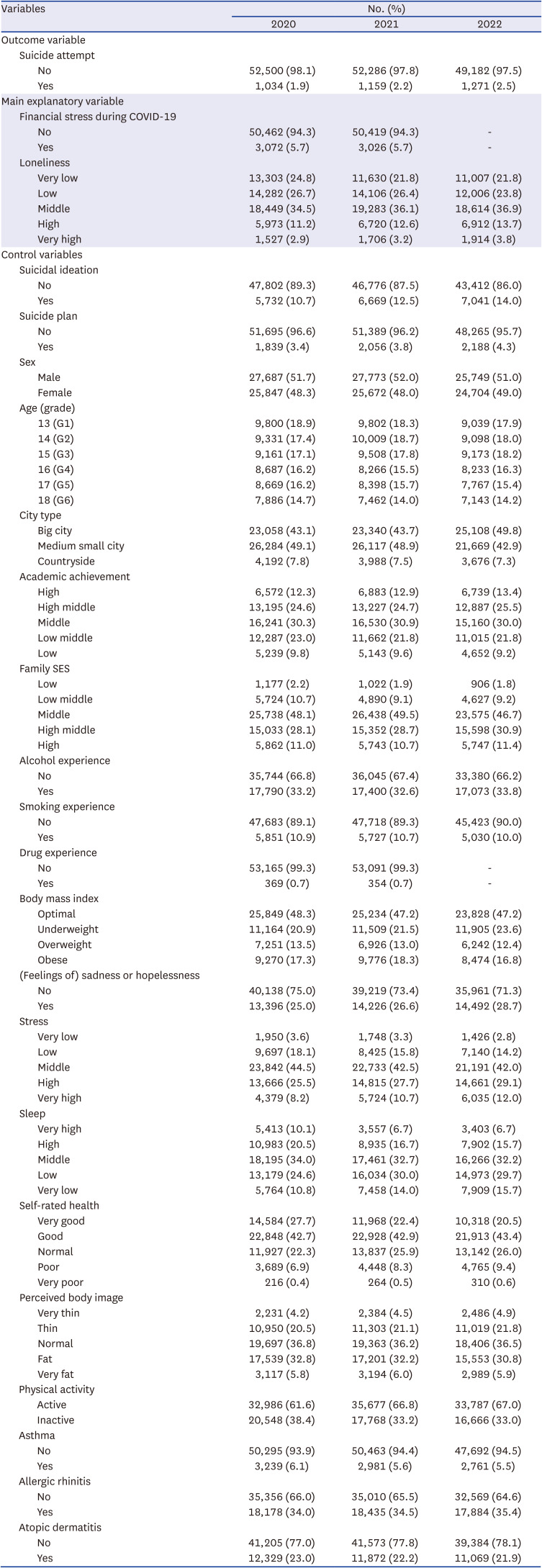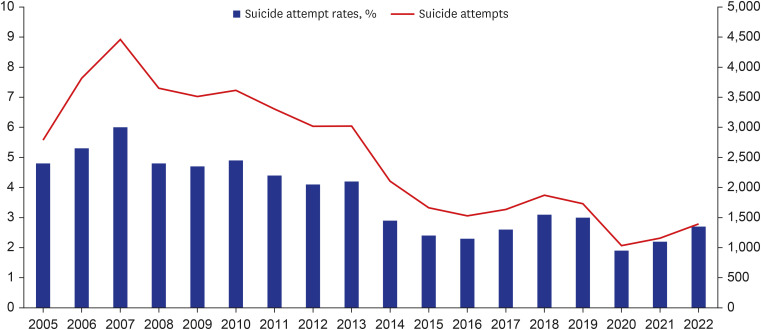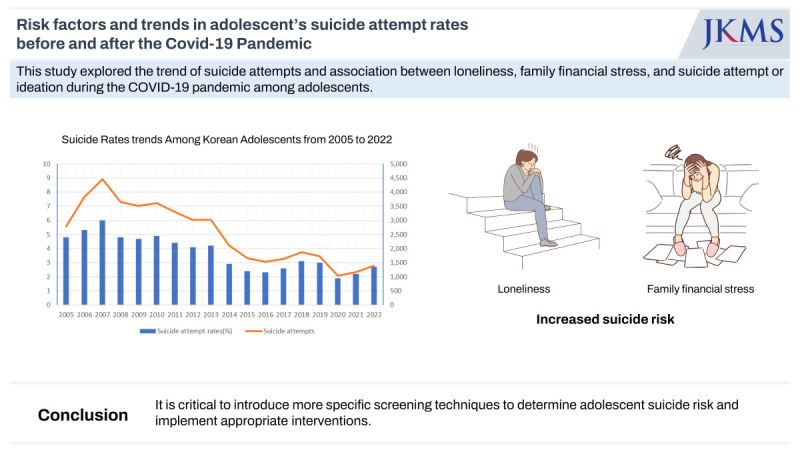|
Sex |
Male |
343 (33.2) |
|
|
403 (34.8) |
|
|
465 (36.6) |
|
|
|
Female |
691 (66.8) |
2.190 (1.922–2.495, P < 0.001)***
|
1.374 (1.155–1.634, P < 0.001)***
|
756 (65.2) |
2.061 (1.824–2.328, P < 0.001)***
|
1.277 (1.090–1.497, P = 0.001)**
|
806 (63.4) |
1.834 (1.634–2.058, P < 0.001)***
|
1.341 (1.155–1.555, P < 0.001)***
|
|
Age |
|
15.090 ± 1.754 |
0.998 (0.964–1.034, P = 0.909) |
1.103 (0.952–1.277, P = 0.192) |
14.870 ± 1.747 |
0.928 (0.897–0.960, P < 0.001)***
|
0.937 (0.813–1.079, P = 0.364) |
14.860 ± 1.716 |
0.921 (0.892–0.952 P < 0.001)***
|
1.004 (0.875–1.151, P = 0.957) |
|
Grade |
G6 |
153 (14.8) |
|
|
143 (12.3) |
|
|
146 (11.5) |
|
|
|
G5 |
181 (17.5) |
1.078 (0.867–1.340, P = 0.500) |
1.149 (0.853–1.549, P = 0.360) |
156 (13.5) |
0.969 (0.770–1.218, P = 0.786) |
0.797 (0.590–1.075, P = 0.137) |
173 (13.6) |
1.092 (0.874–1.364, P = 0.440) |
1.083 (0.809–1.450, P = 0.593) |
|
G4 |
137 (13.2) |
0.810 (0.642–1.022, P = 0.076) |
1.213 (0.816–1.804, P = 0.340) |
162 (14.0) |
1.023 (0.815–1.284, P = 0.844) |
0.849 (0.578–1.247, P = 0.405) |
171 (13.5) |
1.017 (0.813–1.271, P = 0.886) |
1.190 (0.818–1.732, P = 0.362) |
|
G3 |
194 (18.8) |
1.093 (0.883–1.355, P = 0.413) |
1.687 (1.017–2.797, P = 0.043)*
|
201 (17.3) |
1.105 (0.890–1.373, P = 0.365) |
0.784 (0.480–1.281, P = 0.332) |
255 (20.1) |
1.370 (1.115–1.683, P = 0.003)**
|
1.522 (0.943–2.456, P = 0.086) |
|
G2 |
171 (16.5) |
0.944 (0.757–1.176, P = 0.605) |
1.721 (0.910–3.254, P = 0.095) |
242 (20.9) |
1.268 (1.029–1.563, P = 0.026)*
|
0.950 (0.516–1.746, P = 0.868) |
254 (20.0) |
1.376 (1.120–1.691, P = 0.002)**
|
1.553 (0.855–2.821, P = 0.148) |
|
G1 |
198 (19.1) |
1.042 (0.842–1.290, P = 0.704) |
3.066 (1.420–6.619, P = 0.004)**
|
255 (22.0) |
1.367 (1.111–1.681, P = 0.003)**
|
1.068 (0.509–2.243, P = 0.862) |
272 (21.4) |
1.487 (1.213–1.822, P < 0.001)***
|
2.090 (1.013–4.309, P = 0.046)*
|
|
City type |
Countryside |
68 (6.6) |
|
|
90 (7.8) |
|
|
88 (6.9) |
|
|
|
Big city |
454 (43.9) |
1.218 (0.942–1.575, P = 0.132) |
1.315 (0.969–1.784, P = 0.079) |
496 (42.8) |
1.218 (0.942–1.575, P = 0.132) |
0.981 (0.747–1.289, P = 0.893) |
504 (39.7) |
0.971 (0.772–1.221, P = 0.801) |
0.924 (0.708–1.208, P = 0.565) |
|
Medium small city |
512 (49.5) |
1.205 (0.934–1.555, P = 0.152) |
1.173 (0.867–1.587, P = 0.300) |
573 (49.4) |
1.205 (0.934–1.555, P = 0.152) |
0.923 (0.706–1.209, P = 0.562) |
679 (53.4) |
1.133 (0.905–1.419, P = 0.275) |
0.925 (0.807–1.060, P = 0.262) |
|
Financial stress during the COVID-19 pandemic |
No |
882 (85.3) |
|
|
1,007 (86.9) |
|
|
|
|
|
|
Yes |
152 (14.7) |
2.926 (2.454–3.490, P < 0.001)***
|
1.572 (1.244–1.986, P < 0.001)***
|
152 (13.1) |
2.595 (2.179–3.090, P < 0.001)***
|
1.281 (1.014–1.619, P = 0.038)*
|
|
|
|
|
Loneliness |
No |
124 (12.0) |
|
|
121 (10.4) |
|
|
164 (12.9) |
|
|
|
Yes |
910 (88.0) |
8.049 (6.667–9.717, P < 0.001)***
|
1.497 (1.190–1.882, P = 0.001)**
|
1,038 (89.6) |
8.239 (6.820–9.953, P < 0.001)***
|
1.629 (1.303–2.036, P < 0.001)***
|
1,107 (87.1) |
5.857 (4.966–6.907, P < 0.001)***
|
1.269 (1.039–1.552, P = 0.020)*
|
|
Suicidal ideation |
No |
122 (11.8) |
|
|
121 (10.4) |
|
|
162 (12.7) |
|
|
|
Yes |
912 (88.2) |
73.948 (61.075–89.533, P < 0.001)***
|
13.723 (10.836–17.380, P < 0.001)***
|
1,038 (89.6) |
71.076 (58.760–85.974, P < 0.001)***
|
15.123 (12.002–19.056, P < 0.001)***
|
1,109 (87.3) |
49.912 (42.232–58.987, P < 0.001)***
|
13.127 (10.687–16.124, P < 0.001)***
|
|
Suicide plan |
No |
386 (37.3) |
|
|
426 (36.8) |
|
|
532 (41.9) |
|
|
|
Yes |
648 (62.7) |
72.322 (62.968–83.065, P < 0.001)***
|
8.702 (7.397–10.238, P < 0.001)***
|
733 (63.2) |
66.281 (58.126–75.580, P < 0.001)***
|
8.803 (7.567–10.241, P < 0.001)***
|
739 (58.1) |
45.760 (40.460–51.753, P < 0.001)***
|
6.838 (5.934–7.880, P < 0.001)***
|
|
Academic achievement |
High |
89 (8.6) |
|
|
120 (10.4) |
|
|
134 (10.5) |
|
|
|
High middle |
197 (19.1) |
1.104 (0.858–1.421, P = 0.442) |
1.151 (0.854–1.551, P = 0.357) |
220 (19.0) |
0.953 (0.762–1.193, P = 0.676) |
0.966 (0.740–1.260, P = 0.797) |
248 (19.5) |
0.967 (0.782–1.196, P = 0.758) |
1.097 (0.857–1.403, P = 0.462) |
|
Middle |
255 (24.7) |
1.162 (0.911–1.482, P = 0.226) |
1.250 (0.934–1.673, P = 0.134) |
307 (26.5) |
1.067 (0.862–1.320, P = 0.553) |
1.103 (0.851–1.429, P = 0.459) |
328 (25.8) |
1.090 (0.890–1.335 P = 0.405) |
1.358 (0.857–1.403, P = 0.013)*
|
|
Low middle |
279 (27.0) |
1.692 (1.331–2.153, P < 0.001)***
|
1.426 (1.064–1.912, P = 0.018)*
|
315 (27.2) |
1.565 (1.265–1.935, P < 0.001)***
|
1.344 (1.031–1.750, P = 0.029)*
|
335 (26.4) |
1.546 (1.262–1.893, P < 0.001)***
|
1.567 (1.225–2.004, P < 0.001)***
|
|
Low |
214 (20.7) |
3.102 (2.416–3.983, P < 0.001)***
|
1.487 (1.086–2.037, P = 0.013)*
|
197 (17.0) |
2.245 (1.784–2.825, P < 0.001)***
|
1.370 (1.024–1.833, P = 0.034)*
|
226 (17.8) |
2.517 (2.026–3.127, P < 0.001)***
|
1.502 (1.148–1.967, P = 0.003)**
|
|
Family SES |
High |
90 (8.7) |
|
|
116 (10.0) |
|
|
166 (13.1) |
|
|
|
High middle |
258 (25.0) |
1.120 (0.879–1.426, P = 0.359) |
1.030 (0.767–1.383, P = 0.846) |
276 (23.8) |
0.888 (0.713–1.106, P = 0.288) |
0.942 (0.722–1.228, P = 0.657) |
327 (25.7) |
0.720 (0.596–0.870, P = 0.001)**
|
0.812 (0.646–1.021, P = 0.075) |
|
Middle |
420 (40.6) |
1.064 (0.846–1.338, P = 0.597) |
0.885 (0.666–1.176, P = 0.401) |
490 (42.3) |
0.916 (0.747–1.124, P = 0.400) |
0.896 (0.695–1.156, P = 0.400) |
521 (41.0) |
0.760 (0.636–0.907, P = 0.002)**
|
0.803 (0.644–1.001, P = 0.051) |
|
Low middle |
193 (18.7) |
2.238 (1.738–2.882, P < 0.001)***
|
0.927 (0.674–1.274, P = 0.639) |
194 (16.7) |
2.004(1.587–2.530, P < 0.001)***
|
1.088 (0.809–1.462, P = 0.577) |
174 (13.7) |
1.314 (1.058–1.631, P = 0.013)*
|
0.729 (0.559–0.952, P = 0.020)*
|
|
Low |
73 (7.1) |
4.241 (3.904–5.813, P < 0.001)***
|
0.955 (0.628–1.451, P = 0.828) |
83 (7.2) |
4.288 (3.208–5.731, P < 0.001)***
|
1.330 (0.902–1.961, P = 0.150) |
83 (6.5) |
3.391 (2.579–4.457, P < 0.001)***
|
1.154 (0.812–1.640, P = 0.426) |
|
Smoking experience |
No |
722 (69.8) |
|
|
860 (74.2) |
|
|
917 (72.1) |
|
|
|
Yes |
312 (30.2) |
3.664 (3.199–4.196, P < 0.001)***
|
1.882 (1.550–2.285, P < 0.001)***
|
299 (25.8) |
3.001 (2.624–3.434, P < 0.001)***
|
1.584 (1.312–1.912, P < 0.001)***
|
354 (27.9) |
3.674 (3.238–4.269, P < 0.001)***
|
1.837 (1.544–2.186, P < 0.001)***
|
|
Alcohol experience |
No |
445 (43.0) |
|
|
580 (50.0) |
|
|
577 (45.4) |
|
|
|
Yes |
589 (57.0) |
2.716 (2.398–3.076, P < 0.001)***
|
1.301 (1.100–1.539, P = 0.002)**
|
579 (50.0) |
2.105 (1.873–2.365, P < 0.001)***
|
1.163 (0.995–1.359, P = 0.058) |
694 (54.6) |
2.409 (2.154–2.694, P < 0.001)***
|
1.348 (1.165–1.559, P < 0.001)***
|
|
Drug experience |
No |
971 (93.9) |
|
|
1,111 (95.9) |
|
|
|
|
|
|
Yes |
63 (6.1) |
11.067 (8.377–14.621, P < 0.001)***
|
2.540 (1.702–3.790, P < 0.001)***
|
48 (4.1) |
7.339 (5.383–10.007, P < 0.001)***
|
1.505 (0.996–2.275, P = 0.052) |
|
|
|
|
BMI |
Optimal |
499 (48.3) |
|
|
547 (47.2) |
|
|
569 (44.8) |
|
|
|
Underweight |
227 (22.0) |
1.054 (0.900–1.236, P = 0.512) |
1.011 (0.795–1.285, P = 0.929) |
273 (23.6) |
1.097 (0.947–1.270, P = 0.219) |
1.150 (0.926–1.429, P = 0.206) |
320 (25.2) |
1.129 (0.983–1.297, P = 0.086) |
1.010 (0.825–1.237, P = 0.921) |
|
Overweight |
134 (13.0) |
0.957 (0.789–1.160, P = 0.651) |
0.872 (0.680–1.118, P = 0.279) |
139 (12.0) |
0.924 (0.766–1.116, P = 0.412) |
0.952 (0.747–1.214, P = 0.693) |
160 (12.6) |
1.075 (0.900–1.284, P = 0.427) |
1.014 (0.809–1.271, P = 0.906) |
|
Obese |
174 (16.8) |
0.972 (0.816–1.157, P = 0.748) |
0.866 (0.664–1.128, P = 0.285) |
200 (17.3) |
0.943 (0.800–1.110, P = 0.479) |
0.935 (0.725–1.204, P = 0.601) |
222 (17.5) |
1.100 (0.940–1.287, P = 0.236) |
1.040 (0.821–1.317, P = 0.747) |
|
Sadness or hopelessness |
No |
192 (18.6) |
|
|
224 (19.3) |
|
|
286 (22.5) |
|
|
|
Yes |
842 (81.4) |
13.954 (11.914–16.343, P < 0.001)***
|
1.846 (1.519–2.244, P < 0.001)***
|
935 (80.7) |
12.247 (10.571–14.188, P < 0.001)***
|
1.831 (1.527–2.195, P < 0.001)***
|
985 (77.5) |
9.097 (7.963–10.392, P < 0.001)***
|
1.617 (1.373–1.905, P < 0.001)***
|
|
Stress |
Very low |
7 (0.7) |
|
|
7 (0.6) |
|
|
22 (1.7) |
|
|
|
Low |
22 (2.1) |
0.631 (0.269–1.480, P = 0.290) |
0.722 (0.289–1.805, P = 0.486) |
35 (3.0) |
1.038 (0.460–2.340, P = 0.929) |
1.017 (0.417–2.481, P = 0.971) |
51 (4.0) |
0.459 (0.278–0.759, P = 0.002)**
|
0.551 (0.310–0.981, P = 0.043)*
|
|
Middle |
196 (19.0) |
2.301 (1.081–4.897, P = 0.031)*
|
1.112 (0.488–2.537, P = 0.800) |
194 (16.7) |
2.141 (1.006–4.558, P = 0.048)*
|
1.010 (0.438–2.331, P = 0.981) |
196 (15.4) |
0.596 (0.382–0.929, P = 0.022)*
|
0.424 (0.251–0.716, P = 0.001)**
|
|
High |
395 (38.2) |
8.262 (3.907–17.470, P < 0.001)***
|
1.267 (0.555–2.891, P = 0.574) |
422 (36.4) |
7.292 (3.450–15.416, P < 0.001)***
|
1.118 (0.485–2.577, P = 0.794) |
437 (34.4) |
1.961 (1.273–3.019, P = 0.002)**
|
0.504 (0.299–0.849, P = 0.010)*
|
|
Very high |
414 (40.0) |
28.982 (13.704–61.294, P < 0.001)***
|
1.587 (0.692–3.638, P = 0.275) |
501 (43.2) |
23.857 (11.293–50.401, P < 0.001)***
|
1.196 (0.517–2.766, P = 0.676) |
565 (44.5) |
6.592 (4.288–10.133, P < 0.001)***
|
0.631 (0.374–1.066, P = 0.085) |
|
Sleep |
Very high |
65 (6.3) |
|
|
40 (3.5) |
|
|
61 (4.8) |
|
|
|
High |
103 (10.0) |
0.779 (0.570–1.064, P = 0.117) |
0.659 (0.454–0.956, P = 0.028)*
|
114 (9.8) |
1.136 (0.791–1.632, P = 0.489) |
1.040 (0.682–1.586, P = 0.854) |
98 (7.7) |
0.688 (0.498–0.950, P = 0.023)*
|
0.708 (0.490–1.025, P = 0.068) |
|
Middle |
288 (27.9) |
1.323 (1.009–1.735, P = 0.043)*
|
0.699 (0.502–0.974, P = 0.035)*
|
284 (24.5) |
1.454 (1.042–2.028, P = 0.028)*
|
0.950 (0.643–1.404, P = 0.798) |
297 (23.4) |
1.019 (0.772–1.346, P = 0.895) |
0.744 (0.537–1.032, P = 0.076) |
|
Low |
314 (30.4) |
2.008 (1.535–2.628, P < 0.001)***
|
0.676 (0.484–0.946, P = 0.022)*
|
351 (30.3) |
1.968 (1.416–2.735, P < 0.001)***
|
0.832 (0.564–1.228, P = 0.355) |
369 (29.0) |
1.384 (1.053–1.820, P = 0.020)*
|
0.712 (0.514–0.986, P = 0.041)*
|
|
Very low |
264 (25.5) |
3.949 (3.003–5.194, P < 0.001)***
|
0.555 (0.392–0.786, P = 0.001)**
|
370 (31.9) |
4.590 (3.304–6.376, P < 0.001)***
|
0.879 (0.593–1.879, P = 0.522) |
446 (35.1) |
3.274 (2.498–4.292, P < 0.001)***
|
0.839 (0.604–1.165, P = 0.295) |
|
Self-rated health |
Very good |
134 (13.0) |
|
|
137 (11.8) |
|
|
162 (12.7) |
|
|
|
Good |
329 (31.8) |
1.605 (1.311–1.964, P < 0.001)***
|
1.220 (0.960–1.550, P = 0.103) |
330 (28.5) |
1.261 (1.032–1.541, P = 0.023)*
|
0.970 (0.766–1.228, P = 0.801) |
373 (29.3) |
1.086 (0.901–1.307, P = 0.387) |
0.844 (0.678–1.052, P = 0.131) |
|
Normal |
331 (32.0) |
3.136 (2.562–3.838, P < 0.001)***
|
1.337 (1.042–1.715, P = 0.022)*
|
409 (35.3) |
2.630 (2.164–3.197, P < 0.001)***
|
1.105 (0.871–1.403, P = 0.410) |
411 (32.3) |
2.024 (1.684–2.432, P < 0.001)***
|
0.995 (0.795–1.245, P = 0.964) |
|
Poor |
205 (19.8) |
6.464 (5.183–8.061, P < 0.001)***
|
1.386 (1.048–1.832, P = 0.022)*
|
242 (20.9) |
4.969 (4.018–6.145, P < 0.001)***
|
1.024 (0.784–1.338, P = 0.861) |
268 (21.1) |
3.736 (3.064–4.555, P < 0.001)***
|
0.974 (0.759–1.250, P = 0.835) |
|
Very poor |
35 (3.4) |
21.242 (14.240–31.685, P < 0.001)***
|
2.816 (1.605–4.938, P < 0.001)***
|
41 (3.5) |
15.877 (10.932–23.060, P < 0.001)***
|
1.790 (1.084–2.956, P = 0.023)*
|
57 (4.5) |
13.850 (9.996–19.191, P < 0.001)***
|
1.662 (1.082–2.554, P = 0.020)*
|
|
Perceived body image |
Normal |
311 (30.1) |
|
|
409 (35.3) |
|
|
397 (31.2) |
|
|
|
Very thin |
60 (5.8) |
1.723 (1.302–2.279, P < 0.001)***
|
1.451 (0.979–2.153, P = 0.064) |
52 (4.5) |
1.033 (0.772–1.383, P = 0.826) |
0.616 (0.421–0.902, P = 0.013)*
|
80 (6.3) |
1.508 (1.182–1.925, P = 0.001)**
|
1.232 (0.890–1.705, P = 0.209) |
|
Thin |
182 (17.6) |
1.054 (0.876–1.267, P = 0.579) |
1.033 (0.809–1.320, P = 0.793) |
210 (18.1) |
0.877 (0.742–1.038, P = 0.127) |
0.778 (0.623–0.972, P = 0.027)*
|
244 (19.2) |
1.027 (0.874–1.207, P = 0.744) |
1.003 (0.814–1.238, P = 0.974) |
|
Fat |
379 (36.7) |
1.377 (1.183–1.602, P < 0.001)***
|
1.053 (0.859–1.291, P = 0.620) |
380 (32.8) |
1.047 (0.909–1.206, P = 0.525) |
0.817 (0.670–0.995, P = 0.044)*
|
438 (34.5) |
1.315 (1.146–1.508, P < 0.001)***
|
1.027 (0.852–1.238, P = 0.778) |
|
Very fat |
102 (9.9) |
2.109 (1.681–2.646, P < 0.001)***
|
1.191 (0.844–1.683, P = 0.320) |
108 (9.3) |
1.622 (1.308–2.012, P < 0.001)***
|
0.813 (0.582–1.137, P = 0.226) |
112 (8.8) |
1.766 (1.427–2.186, P < 0.001)***
|
1.018 (0.744–1.393, P = 0.911) |
|
Physical activity |
Active |
659 (63.7) |
|
|
794 (68.5) |
|
|
905 (71.2) |
|
|
|
Inactive |
375 (36.3) |
0.912 (0.802–1.036, P = 0.158) |
0.839 (0.716–0.982, P = 0.029)*
|
365 (31.5) |
0.921 (0.813–1.044, P = 0.200) |
0.914 (0.785–1.064, P = 0.247) |
366 (28.8) |
0.816 (0.722–0.922, P = 0.001)**
|
0.821 (0.709–0.951, P = 0.008)**
|
|
Asthma experience |
No |
943 (91.2) |
|
|
1,065 (91.9) |
|
|
1,131 (89.0) |
|
|
|
Yes |
91 (8.8) |
1.513 (1.216–1.882, P < 0.001)***
|
1.077 (0.820–1.415, P = 0.595) |
94 (8.1) |
1.510 (1.219–1.870, P < 0.001)***
|
1.203 (0.924–1.566, P = 0.169) |
140 (11.0) |
2.199 (1.837–2.633, P < 0.001)***
|
1.432 (1.142–1.794, P = 0.002)**
|
|
Allergic rhinitis experience |
No |
648 (62.7) |
|
|
692 (59.7) |
|
|
767 (60.3) |
|
|
|
Yes |
386 (37.3) |
1.162 (1.023–1.320, P = 0.021)*
|
0.968 (0.826–1.136, P = 0.693) |
467 (40.3) |
1.289 (1.145–1.451, P < 0.001)***
|
0.980 (0.845–1.137, P = 0.788) |
504 (39.7) |
1.202 (1.073–1.347, P = 0.002)**
|
0.953 (0.829–1.095, P = 0.496) |
|
Atopic dermatitis experience |
No |
758 (73.3) |
|
|
851 (73.4) |
|
|
950 (74.7) |
|
|
|
Yes |
276 (26.7) |
1.222 (1.063–1.404, P = 0.005)**
|
0.928 (0.782–1.102, P = 0.395) |
308 (26.6) |
1.275 (1.117–1.454, P < 0.001)***
|
0.964 (0.820–1.132, P = 0.653) |
321 (25.3) |
1.208 (1.063–1.374, P = 0.004)**
|
0.972 (0.833–1.135, P = 0.721) |







 PDF
PDF Citation
Citation Print
Print




 XML Download
XML Download